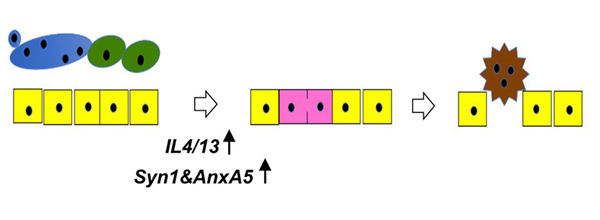
-Courtesy of the Eunice Kennedy Shriver National Institute of Child Health and Human Development, National Institutes of Health
WHAT:
Proximity to nearby muscle cells may make prostate cancer cells more likely to invade nearby tissues and spread to other organs, according to an early study by researchers at the National Institutes of Health. The presence of muscle cells appears to make cancer cells more likely to fuse two or more cancer cells into a single cell, thereby increasing their invasiveness and ability to spread. The study was led by Berna Uygur, Ph.D., of NIH’s Eunice Kennedy Shriver National Institute of Child Health and Human Development (NICHD) and includes colleagues from the National Eye Institute and the Maine Medical Center Research Institute in Scarborough. The study appears in Molecular Cancer Research.
Researchers grew human prostate cancer cells in laboratory dishes along with human muscle cells—stand-ins for the smooth muscle surrounding the prostate gland and the striated muscle of the urethral sphincter at the base of the prostate. The muscle cells secreted interleukins 4 and 13, cellular proteins that stimulated the cancer cells to produce two additional proteins, annexin A5 and syncytin 1, which triggered the cancer cells to fuse together. Testing revealed that the fused cells developed characteristics of more malignant cells, which are more likely to invade surrounding tissues and spread to other parts of the body. The researchers note that drugs to inhibit annexin A5 and syncytin 1 could be studied for their potential to treat prostate cancer. According to the National Cancer Institute, approximately 11.2 percent of men in the United States will be diagnosed with prostate cancer at some point during their lifetime.
WHO:
Leonid Chernomordik, Ph.D., senior investigator in the NICHD Section on Membrane Biology, is available for interviews.
ARTICLE:
Uygur, B, et al. Interactions with muscle cells boost fusion, stemness, and drug resistance of prostate cancer cells. Molecular Cancer Research. 2018.
###
This press release describes a basic research finding. Basic research increases our understanding of human behavior and biology, which is foundational to advancing new and better ways to prevent, diagnose, and treat disease. Science is an unpredictable and incremental process—each research advance builds on past discoveries, often in unexpected ways. Most clinical advances would not be possible without the knowledge of fundamental basic research.
About the Eunice Kennedy Shriver National Institute of Child Health and Human Development (NICHD): NICHD conducts and supports research in the United States and throughout the world on fetal, infant and child development; maternal, child and family health; reproductive biology and population issues; and medical rehabilitation. For more information, visit NICHD’s website.
About the National Institutes of Health (NIH): NIH, the nation's medical research agency, includes 27 Institutes and Centers and is a component of the U.S. Department of Health and Human Services. NIH is the primary federal agency conducting and supporting basic, clinical, and translational medical research, and is investigating the causes, treatments, and cures for both common and rare diseases. For more information about NIH and its programs, visit http://www.nih.gov.

 BACK TO TOP
BACK TO TOP